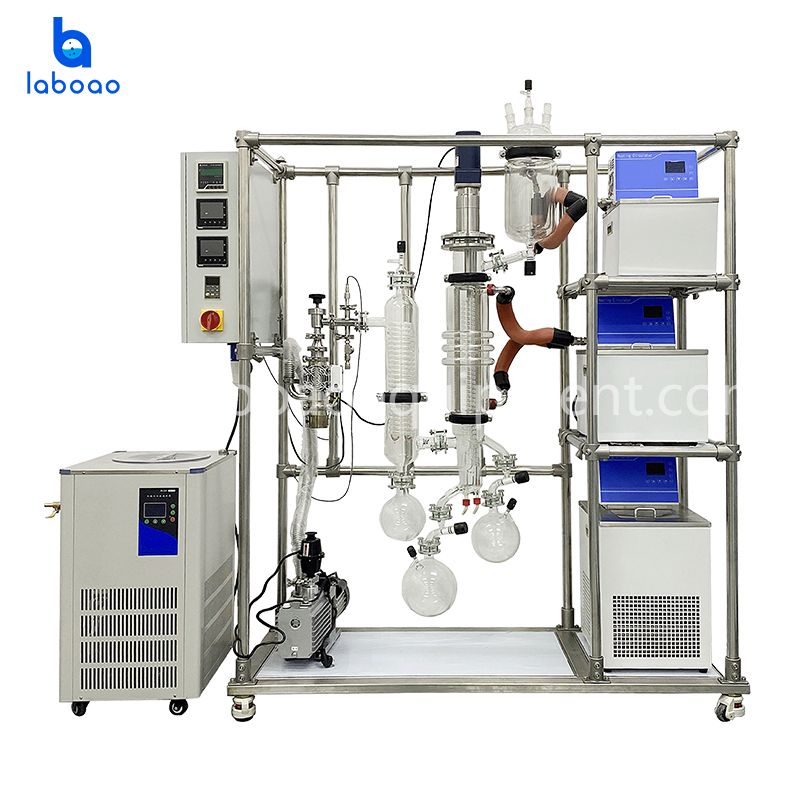Classification Of Thin Film Evaporators And How To Choose?
So what types of thin film evaporators are there? How are they classified? How to choose a suitable thin film evaporator?
First of all, thin film evaporators are divided into four types according to the flow direction of materials in the evaporator and the reasons for film formation: rising film evaporator, falling film evaporator, rising-falling film evaporator, and wiped film evaporator.
Classification and comparison of thin film evaporators
Name | Direction of material flow | Cause of film formation | Scope of application |
Rising film evaporator | bottom up | heated evaporative flow | Dilute solutions, heat sensitive and foaming solutions |
Falling film evaporator | top down | Gravity | Materials with higher concentration and higher viscosity. Solutions that are prone to crystallization and scaling are not applicable |
Rising-falling film evaporator | first rise then fall | Evaporative flow Gravity | Materials with a large viscosity change and a small amount of water evaporation |
Wiped film evaporator | top down | rotating blade Squeegee film forming | Materials with high viscosity, heat sensitivity and easy to crystallize and scale |
1. Rising film evaporator
The raw material liquid of the rising film evaporator enters from the bottom of the evaporator after preheating, and the heating steam is condensed outside the tube.
When the solution is heated and boiled, it vaporizes rapidly. The generated secondary steam rises at a high speed in the tube, driving the liquid to flow upward in a film-like shape along the inner wall of the tube. The rising liquid film continues to evaporate due to heating. Therefore, the solution is gradually evaporated in the process of rising from the bottom of the evaporator to the top. The concentrated solution enters the separation chamber and is separated from the secondary steam and discharged from the bottom of the separator.
Rising film evaporators are suitable for solutions with large evaporation (that is, dilute solutions), heat-sensitive and foaming solutions. But it is not suitable for solutions with high viscosity, crystal precipitation or easy scaling.
2. Falling film evaporator
The raw material liquid of the falling film evaporator is added from the top of the heating tube.
The solution flows down in the form of a film along the inner wall of the tube under the action of its own gravity, and is evaporated and concentrated. The vapor-liquid mixture enters the separation chamber from the bottom of the heating tube, and after the gas-liquid separation, the completed liquid is discharged from the bottom of the separator.
In order to make the solution form a film evenly on the wall, a liquid film distributor should be installed on the top of each heating tube. There are many types of film distributors. Falling film evaporators can evaporate solutions with higher concentrations and are also suitable for materials with higher viscosity. However, it is not suitable for solutions that are prone to crystallization or scaling. In addition, since the liquid film is not easily distributed uniformly in the tube, its heat transfer coefficient is smaller than that of the rising film evaporator.
3. Rising-falling film evaporator
The rising-film and falling-film evaporators are installed in one shell, which constitutes a rising-falling-film evaporator. After preheating, the raw material liquid first rises from the rising film heating chamber, then descends from the falling film heater, and then separates from the secondary steam in the separation chamber to obtain the complete liquid.
This type of evaporator is mostly used in situations where the viscosity of the solution changes greatly during the evaporation process, the amount of water evaporation is not large, and the height of the plant is limited.
4. Wiped film evaporator
The scraper thin film evaporator uses the scraping action of the rotating scraper to quickly stir the liquid into a film.
Because the scraper type thin film evaporator has a large gas passage space, the vacuum degree can reach within 10Pa, so that the material can be operated away from the boiling point, and the thermal decomposition of the product is reduced.
In addition, the unique structure of the scraper film evaporator makes the material stay in the evaporator for a short time, and the evaporation is strong and efficient. At the same time, it is also suitable for processing materials with heat sensitivity and stable evaporation, high viscosity and sharp increase in viscosity with the increase of concentration, and the evaporation process can also be smoothly evaporated. It can also be successfully used in the evaporation and distillation of materials containing solid particles, crystallization, polymerization, scaling, etc.
Thin film evaporator selection suggestion
In the selection of thin film evaporators, various factors must be considered comprehensively, generally:
▲Production capacity and operating parameters: including processing capacity, in and out concentration, temperature, annual operating hours, etc.;
▲Product characteristics: including heat sensitivity, viscosity and fluidity (at operating temperature), foamability, solid content, crystallization and polymerization tendency, etc.;
▲Operating medium: such as water vapor (pressure), cooling water (temperature), cleaning fluid (solvent), etc.;
▲Material selection and surface polishing requirements for manufacture;
▲Site conditions: such as space, climate (outdoor), connection between energy and products, working platform, etc.
▲Regulations: including safety, noise, environmental protection, etc.







-analyzer-1695623743955.jpg)

